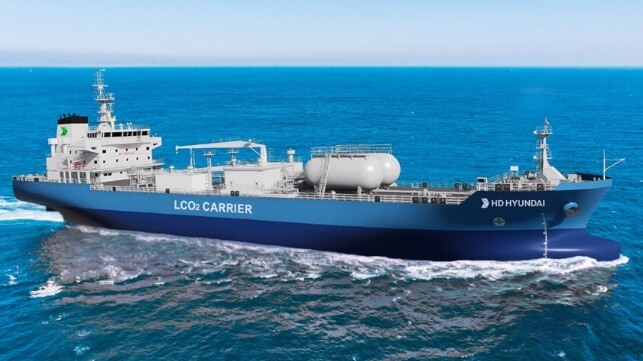55 Vessels Required by 2030 for Emerging CO2 Transport and Storage

The drive for global decarbonization and the efforts to capture and store large quantities of CO2 emissions for industrial emitters is expected to create a new segment of the shipping industry. As the industry emerges, investments are projected for onshore infrastructure including pipelines and terminals as well as shipping to assist in the transfer of mostly liquid CO2 from collection points to the offshore storage sites.
“Carbon dioxide shipping is a nascent market now, but it’s set to play a significant role in the global climate solution,” says Lein Mann Bergsmark, vice president of supply chain research for Rystad Energy in its new research. “The transportation of carbon dioxide (CO2) is taking to the seas as emitters look for flexible ways to move captured carbon to offshore storage projects,” they write in the research report.
Demonstrating this, today Höegh LNG and Aker BP announced they have entered a strategic partnership to develop a comprehensive carbon transport and storage (CCS) offering for industrial CO2 emitters in Northern Europe. They are the latest in a series of companies to begin exploring the opportunities. South Korea’s HD Hyundai through its Korea Shipbuilding & Marine Engineering also recently received an order for two large commercial CO2 carriers (22,000 cbm gas) designed for the charter market.
Northern Lights, a Norwegian project being developed in a partnership between Equinor, Shell, and TotalEnergies, is among the most advanced efforts, having recently completed construction of portions of its onshore storage facility for a terminal in Norway. The project, which is known as an open-source CO2 transport and storage network as it will be contracting to take CO2 for a range of emitters, is seen as the model emerging for the segment. Northern Lights already has two CO2 transport vessels (each with a capacity of 7,500 cbm) under construction in China and last week announced it has ordered a third in response to increasing demand for cross-border CO2 transport and storage.
Based on planned carbon capture projects, Rystad estimates in its new research that annually more than 90 million tonnes (tpa) of CO2 will be shipped by the end of the decade. To meet those levels, they forecast that a fleet of 55 carriers will be required by 2030 along with 48 terminals to handle the import and export of CO2. Shipping, along with onshore and offshore pipelines they forecast will make up the industry while noting that CO2 shipping will be the most flexible solution for carrying carbon emissions over long distances at a relatively low cost.
The North Sea they highlight is set to take center stage in the CO2 shipping surge due to its proximity to major populated areas in Northern Europe. Norway, they expect will account for nearly a third (30 percent) of the CO2 shipped globally in 2030 with 26 million tpa. The Netherlands follows Norway, with 23 million tpa, and the UK, with about 20 million tpa of forecast shipping volumes. Other countries that do not have ample opportunities to store their CO2 emissions domestically, including France and Belgium, are also expected to adopt the CO2 shipping model.
Internationally, they expect Australia will also be a significant player in the global market, shipping and storing CO2 from domestic projects and neighboring Asia-Pacific countries, including Japan.
Most of the proposed shipping routes, including those in Europe and around Australia, are relatively short routes of no more than approximately 1,500 miles. However, planned routes between Japan, Malaysia, and Australia would involve sailing more than 3,100 miles. The longest journey announced to date would be between South Korea and Saudi Arabia, a one-way trip of nearly 7,500 miles.
To make LCO2 shipping truly work, Rystad Energy notes shipping must abandon its current use of conventional fuels like maritime diesel or low-sulfur fuel oil (LSFO). Based on their research of CO2 shipping routes that could come online in 2030, could emit as much as five percent of the total CO2 shipped. Switching to LNG as the shipping fuel could cut emissions by 18 percent say Rystad, while blue methanol would result in a 20 percent drop, and when blue ammonia is available it would slash the emissions impact of the shipping process by up to 80 percent.
Northern Lights, which is the first to build dedicated CO2 carriers for the transport and storage operation, is fueling its ships with LNG. In addition, they will use a rotor to provide wind-assisted propulsion system and air lubrication to reduce drag on the hull. The shipbuilding and design industry is working on the concepts for the next generation of larger ships that would be able to transport larger quantities of LCO2 either for storage or reuse.
